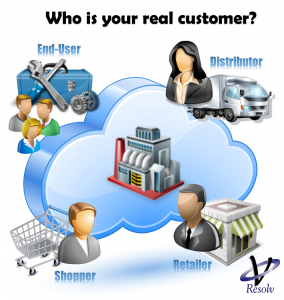As manufacturers put together their marketing plan for next year they often find themselves in a bit of a quandary in defining who their “real” customer is. More-often-than-not manufactures have little direct contact with the end user of their product. They sell through a distributor who sells to a purchasing agent, neither of whom are the end-user of their product. This makes putting together a marketing plan rather difficult, especially if the manufacturer’s product does not end up on a retail shelf.
People say “I don’t see the problem, Luke, always market to the end-user.” This may work, as I said, if your product ends up on a retail shelf, but even then, the end-user is often not the person that makes the buying decision. Look at the first graphic below. In this case the manufacturer makes the product and sells it through a distributor to a retailer who sells it to someone shopping in their store who buys it for a family member. It may be that the family member asked for the product specifically, or it may be that the family member said something like “I need socks,” leaving the final purchasing decision to the shopper, who is not the end-user.
This is even more of an issue when a manufacturer is selling their product to a business. The graphic below will help describe the issue. In this case the manufacture is still selling through a distributor, but now a purchasing agent at the purchasing company is in charge of ordering. If it is a big-ticket item, they are acting on behalf of the CEO or other upper-manager. However, most-likely neither the CEO nor the purchasing agent is the end-user of the product. It may be that the end-user was consulted prior to the purchase decision, and it may be that they weren’t.
Back to the marketing plan. Who should the manufacturer market to? Let’s look at all of the possibilities:
· End-user: This person is the ultimate user of the product. They may have given specific input into the desired purchase result. This person may not hold the purse strings.
· CEO (or upper management): The CEO directly or indirectly approves all purchases. They may give specific direction into the desired purchase. This direction may be in the form of an available budget to work within. The CEO/Manager usually never uses the product.
· Purchasing agent/shopper: This person works within the guidelines set out, and makes purchases based on those guidelines. The guidelines may be specific, or loose, depending on the product. The purchasing agent usually never uses the product.
· Retailer: The retailer is concerned with “selling what moves.” They may or may not market a specific product. They usually base product decision based on profit and inventory turn. The retailer may employ end-users but most-likely do not use the product at the retail store.
· Distributor: The distributor usually earns commission on selling product. They may or may not exclusively sell for one manufacturer. When selling multiple products (either from the same manufacturer or from multiple manufacturers) they will sell what they know best and what makes them the most money.
So, should you market to the end-user? Yes. They often have a say in the purchase. This is especially important if the product is more expensive than a competing product, because the end-user may be able to influence the budget set by the CEO/manager. However, keep in mind, the end-user frequently does not approve the budget, nor are they the final say in the purchase.
What about the CEO? Yes. While they don’t use the product, and product x is the same as product y to them, they approve the budget, and often give direction on product selection.
The purchasing agent/shopper? Of course! They make the purchase. This is especially true for manufacturers that manufacture consumable goods. The manufacturer’s relationship with a purchasing organization is only as good as their relationship with the purchase agent.
Should the manufacturer market to the retailer? All the time! Product placement and display is huge. Don’t leave it up to the retailer to decide how and where to shelf your product. Give advice, get involved. The more manufacturers can help retailers to move product the more the retailers will buy.
Lastly, do you need to market to the distributor (or manufacturer reps)? It’s a resounding yes! They represent the manufacturer in the marketplace. However, the number one rule of marketing is that people forget. Even distributors forget. They forget about benefits of one product over another. They forget about slower selling products. They forget about features. Distributors need to be continually reminded of manufacturers’ products.
So, as manufacturers are putting together marketing plans for next year, I hope they are planning to market to all involved in the purchase, not just the end-user. Keep in mind, that the marketing for each should take on a different form and have a different message. What is important to the end-user is not important to the CEO. The distributor has a higher base-knowledge about the manufacturer’s product than does the purchasing agent. You get my point.
It may seem like a nightmare to coordinate and correlate. Most marketing departments are having to justify every marketing dollar and show the results of each spend. It is difficult to tie marketing to a final sale when targeting 5 different groups with 5 different messages. However, it is not impossible, and CRM software with marketing enhancements can help to tie it all together. Before you put together your marketing plan this year, let’s talk about how you can best track your results.
Luke Russell





